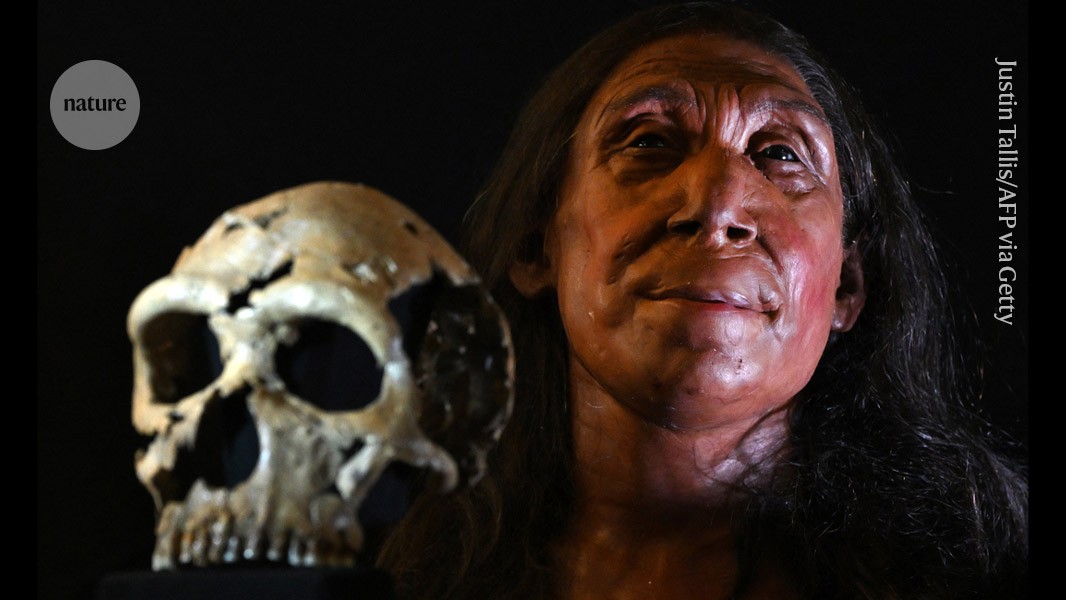Neanderthal–human baby-making was recent — and brief

Analysis of dozens of ancient genomes reveals that close encounters between the two species took place within a narrow window of time

Neanderthals (reconstruction, right, and fossil) and Homo sapiens started to have children together some 47,000 years ago.Credit: Justin Tallis/AFP via Getty
Some 60,000 years ago, Neanderthals in western Eurasia acquired strange new neighbours: a wave of Homo sapiens migrants making their way out of Africa, en route to future global dominance. Now, a study1 of hundreds of ancient and modern genomes has pinpointed when the two species began pairing off — and has found that the genetic intermingling lasted for only a short time, at least on an evolutionary scale.
The high-resolution analysis also allowed the authors to track when certain Neanderthal DNA sequences appeared in the H. sapiens genome and determine whether they were retained. The findings were published earlier this month on the preprint server bioRxiv. They have not yet been peer reviewed.
Genetic legacy
Relations between a good number of humans and Neanderthals (Homo neanderthalensis) must have been cordial: almost every living individual not of African ancestry carries genetic remnants of past pairings between the two species. Previous estimates indicated that this mixing occurred over a broad period between 50,000 and 60,000 years ago2,3, but the actual timing of this ‘gene flow’ and its long-term consequences remain poorly understood.
Earlier studies2,3 tried to understand this history by comparing contemporary human genomes with a small number of Neanderthal ones. But this approach makes it challenging for researchers to define where Neanderthal sequences in the modern genome start and end.
To address this challenge, Leonardo Iasi, an evolutionary geneticist at the Max Planck Institute for Evolutionary Anthropology in Leipzig, Germany, and his colleagues analysed 58 individuals who lived between 2,200 and 45,000 years ago and compared their DNA with that of 231 modern individuals of diverse ancestries other than African ones. People of full African ancestry don’t carry substantial amounts of Neanderthal DNA because their forebears were not part of the exodus from the continent while Neanderthals were alive.
This large-scale, multi-millennia-spanning comparison made it more straightforward to monitor ‘introgression’ of Neanderthal-derived sequences into the modern human genome. The results indicated that Neanderthal-derived genetic contributions in the modern samples could be traced to a single ‘pulse’ of gene flow starting roughly 47,000 years ago — more recently than originally projected —and spanning some 6,800 years, ending around the same time that Neanderthals were nearing extinction. Nearly 7,000 years might seem like a long time, but it is remarkably short on evolutionary timescales considering the sizable changes that the human genome underwent.
Neanderthal deserts
Notably, many of the Neanderthals’ genomic contributions were subsequently removed with remarkable speed from the H. sapiens genome. Modern human genomes contain vast ‘deserts’ that have been fully cleared of Neanderthal remnants — but the authors detected these deserts even in ancient genomes from the latest stages of human–Neanderthal interaction. According to Emilia Huerta-Sanchez, an evolutionary biologist at Brown University in Providence, Rhode Island, this suggests that many Neanderthal sequences could have been detrimental to humans, and were therefore actively and rapidly selected against by evolution.
Huerta-Sanchez says this work fills important gaps in ancient human history. “One of the strengths of the study is that by incorporating ancient human genomes, they learnt more about how evolutionary forces have shaped Neanderthal variation in human populations,” she says.
But other gaps remain. For example, ancestral human genomic data from some geographical regions, including Oceania and East Asia, are much scarcer than from western Eurasia. East Asia is particularly intriguing, because modern humans in the region retain especially high levels of Neanderthal DNA — roughly 20% more than do European people.
The authors declined to speak to Nature for this article.
doi: https://doi.org/10.1038/d41586-024-01452-3
This story originally appeared on: Nature - Author:Michael Eisenstein


















